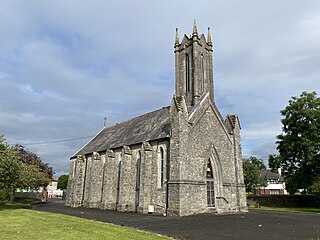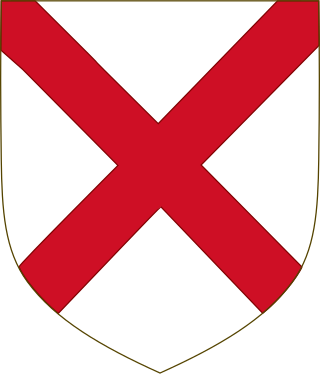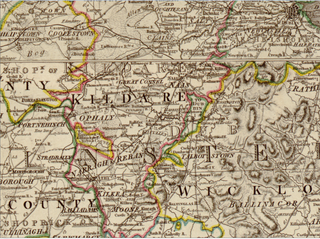Related Research Articles

Duke of Leinster is a title and the premier dukedom in the Peerage of Ireland. The subsidiary titles of the Duke of Leinster are: Marquess of Kildare (1761), Earl of Kildare (1316), Earl of Offaly (1761), Viscount Leinster, of Taplow in the County of Buckingham (1747), Baron of Offaly, Baron Offaly (1620) and Baron Kildare, of Kildare in the County of Kildare (1870). The viscounty of Leinster is in the Peerage of Great Britain, the barony of Kildare in the Peerage of the United Kingdom, and all other titles in the Peerage of Ireland. The courtesy title of the eldest son and heir of the Duke of Leinster is Marquess of Kildare. The Duke of Leinster is the head of the House of Kildare.

Dr. James Kildare is a fictional American medical doctor, originally created in the 1930s by the author Frederick Schiller Faust under the pen name Max Brand. Shortly after the character's first appearance in a magazine story, Paramount Pictures used the story and character as the basis for the 1937 film Internes Can't Take Money, starring Joel McCrea as Jimmie Kildare. Metro-Goldwyn-Mayer (MGM) subsequently acquired the rights and featured Kildare as the primary character in a series of American theatrical films in the late 1930s and early 1940s. Several of these films were co-written by Faust, who also continued to write magazine stories and novels about the character until the early 1940s. Kildare was portrayed by Lew Ayres in nine MGM films. Later films set in the same hospital featured Dr. Gillespie. Ayres returned to voice the Kildare character in an early 1950s radio series. The 1961–1966 Dr. Kildare television series made a star of Richard Chamberlain and gave birth to a comic book and comic strip based on the show. A short-lived reboot of the TV series, Young Doctor Kildare, debuted in 1972 and ran for 24 episodes.

Kildare is a town in County Kildare, Ireland. As of 2022, its population was 10,302, making it the 7th largest town in County Kildare. It is home to Kildare Cathedral, historically the site of an important abbey said to have been founded by Saint Brigid of Kildare in the 5th century. The Curragh lies east of the town.

Oving is a village and also a civil parish within Aylesbury Vale district in Buckinghamshire, England. It is located about three and a half miles north east of Waddesdon, four miles south of Winslow.

Athy is a market town at the meeting of the River Barrow and the Grand Canal in south-west County Kildare, Ireland, 72 kilometres southwest of Dublin. A population of 11,035 made it the sixth largest town in Kildare and the 45th largest in the Republic of Ireland, a growth of 82% since the 2002 census.

Newbridge, officially known by its Irish name Droichead Nua, is a town in County Kildare, Ireland. While the nearby Great Connell Priory was founded in the 13th century, the town itself formed from the 18th century onwards, and grew rapidly alongside a military barracks which opened in the early 19th century. Taking on the name Newbridge in the 20th century, the town expanded to support the local catchment, and also as a commuter town for Dublin. Doubling in population during the 20 years between 1991 and 2011, its population of 24,366 in 2022 makes it the second largest town in Kildare and the sixteenth-largest in Ireland.

Thomastown, historically known as Grennan, is a town in County Kilkenny in the province of Leinster in the south-east of Ireland. It is a market town along a stretch of the River Nore which is known for its salmon and trout, with a number of historical landmarks in the vicinity. Visitor attractions include Jerpoint Abbey, Kilfane Glen gardens, and Mount Juliet Golf Course. The town is in a civil parish of the same name. As of the 2022 census, Thomastown had a population of 2,305, making the town the third most populous in the county.

The FitzGerald dynasty is a Hiberno-Norman noble and aristocratic dynasty, originally of Cambro-Norman and Anglo-Norman origin. They have been peers of Ireland since at least the 13th century, and are described in the Annals of the Four Masters as having become "more Irish than the Irish themselves" or Gaels, due to assimilation with the native Gaelic aristocratic and popular culture. The dynasty has also been referred to as the Geraldines and Ireland's largest landowners. They achieved power through colonisation and the conquest of large swathes of Irish territory by the sons and grandsons of Gerald de Windsor. Gerald de Windsor was the first Castellan of Pembroke Castle in Wales, and became the male progenitor of the FitzMaurice and FitzGerald Dynasty. His father, Baron Walter FitzOther, was the first Constable and Governor of Windsor Castle for William the Conqueror, and was the Lord of 38 manors in England, making the FitzGeralds one of the "service families" on whom the King relied for his survival. Some of its members became the Black Knights, Green Knights and White Knights.

Pilsworth is an area in the Metropolitan Borough of Bury, Greater Manchester, England. Historically, it was a township and civil parish, but in 1894 it was divided between Bury, Heywood, and Unsworth.
Events from the year 1513 in Ireland.
Events from the year 1535 in Ireland.

The Dean of Christ Church Cathedral, Dublin is dean and head of the chapter of the Cathedral of the Holy Trinity, commonly called Christ Church Cathedral, which is the cathedral church of the United Diocese of Dublin and Glendalough in the Church of Ireland. The dean is appointed by the Church of Ireland Archbishop of Dublin. Aspects of the cathedral administration are overseen by the Cathedral Board, which the Dean chairs with both a regular and a casting vote.
Kildare was a constituency represented in the Irish House of Commons until 1801.

The High Sheriff of Kildare was the British Crown's judicial representative in County Kildare, Ireland from the 16th century until 1922, when the office was abolished in the new Free State and replaced by the office of Kildare County Sheriff. The High Sheriff had judicial, electoral, ceremonial and administrative functions and executed High Court Writs. In 1908, an Order in Council made the Lord Lieutenant the Sovereign's prime representative in a county and reduced the High Sheriff's precedence. However, the sheriff retained his responsibilities for the preservation of law and order in the county. The usual procedure for appointing the sheriff from 1660 onwards was that three persons were nominated at the beginning of each year from the county and the Lord Lieutenant then appointed his choice as High Sheriff for the remainder of the year. Often the other nominees were appointed as under-sheriffs. Sometimes a sheriff did not serve his full term due to death or another event, and another sheriff was then appointed for the remainder of the year. The dates given in this article are the dates of appointment.
The Dean of Kildare is based at The Cathedral Church of St Brigid, Kildare in the united Diocese of Meath and Kildare within the Church of Ireland.
William Pilsworth was Church of Ireland Bishop of Kildare between 1604 and 1635. Nominated to the see on 23 July 1604, he was consecrated on 11 September 1604 and served as bishop until his death on 9 May 1635. Prior to his consecration as bishop he was Prebendary of Monmohenock, a post he retained concurrently with the bishopric. He was also vicar of St David's Church, Naas.
Charles Pilsworth was a British politician. He was Member of Parliament for Aylesbury from 1741 to 1747.

Dr. Kildare is an NBC medical drama television series which originally ran from September 28, 1961, until August 30, 1966, for a total of 191 episodes over five seasons. Produced by MGM Television, it was based on fictional doctor characters originally created by author Max Brand in the 1930s and previously used by MGM in a popular film series and radio drama. The TV series quickly achieved success and made a star of Richard Chamberlain, who played the title role. Dr. Kildare inspired or influenced many later TV shows dealing with the medical field. Dr. Kildare aired on NBC affiliate stations on Thursday nights at 8:30–9:30 p.m. until September 1965, when the timeslot was changed to Monday and Tuesday nights at 8:30–9:00 p.m. through the end of the show's run.
Donadea is a civil parish in the barony of Ikeathy and Oughterany in the north of County Kildare, Ireland. There are seven townlands in the parish. There are no large centres of population in the parish. Donadea is noted for its public forest park which is one of the most popular outdoor venues in county Kildare. The nearest villages are Staplestown and Prosperous. The parish name is derived from a church, traditionally said to have been founded by Saint Patrick. A small 17th-century church of the Church of Ireland, St Peter's, still exists within the Donadea demesne.
With the exception of the city of Galway, western Ireland has been described as a wild and desolate land during this time, with few trading commodities and little industry. In 1502, fishing was the dominant industry on the west coast. Recognised internationally for abundant cod, hake and herring, the coastline attracted fishing fleets from as far as Spain.
References
- "Peter O'Higgins, Martyr, Lifesaver, Thought Criminal". Eclectic Christian. 26 March 2009. Archived from the original on 30 January 2012. Retrieved 27 April 2013.